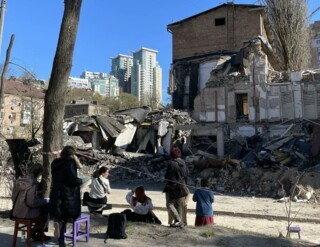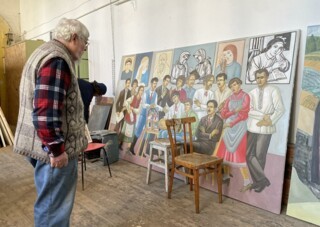Still Drawing
Maxim Edwards
The Mykhailo Boychuk Kyiv State Academy of Decorative and Applied Arts and Design was bombed in a Russian attack on 25 March. When I visited not long afterwards, a group of students were sitting on a grass verge, sketching what remained of their art school. ‘They’re destroying us, but we’re still drawing nevertheless,’ one of the teachers, Volodymyr Pryadka, said with a laugh.
On 20 April the US House of Representatives finally passed a bill which will provide $60 billion of military aid to Ukraine. It comes after massive Russian missile strikes on Ukrainian cities in March, which have since concentrated on the country’s energy infrastructure. The US funds could replenish Ukraine’s depleted anti-air capabilities; Germany recently agreed to furnish Kyiv with another Patriot air defence system.
As the attack on the Boychuk academy shows, Russian missiles can elude the capital’s defences. At around 10:30 on the morning of 25 March, according to the rector, Olena Osadcha, a Russian missile destroyed a section of the academy containing the gym and a workshop used by the department of monumental art. Only one person was injured in the attack: Professor Aneta Kolisnyk was in the workshop but moved away from the windows just in time.
‘Everybody survived. We’re lucky that there weren’t any lessons scheduled in that wing at the time; lessons there usually begin at 12 o’clock,’ explained Alina Bankova, an artist who teaches at the academy. Several students and staff were absent because 25 March is the Feast of the Annunciation.
I saw canvases saved from the rubble piled up in the atrium. In the courtyard beyond I met Yehor Gusev, holding an artist’s palette. Like many of the academy’s six hundred or so students, he was in a nearby dormitory on the morning of the attack. The explosion happened less than a minute after the air-raid siren sounded, he said. ‘Nobody had time to go to the bomb shelter.’
In Pryadka’s studio, an immense painting was being completed by one of his students from Zaporizhzhia. It shows fourteen men and women of the ‘Executed Renaissance’, some of the modernist artists and writers who flourished in Soviet Ukraine in the 1920s and early 1930s, particularly in its then capital, Kharkiv, until Stalin put a stop to them. Mykhailo Boychuk was one. He was accused of espionage and executed by the secret police in 1937. ‘They all suffered,’ Pryadka said. Of the fourteen in the painting, ‘six were shot, others were sent to camps in Siberia.’ The Slovo building in Kharkiv, shelled in March 2022, was once home to a number of the artists of the Executed Renaissance.
Pryadka, who is now 82, designed several mosaics during the Soviet period which can still be seen across Kyiv. Attitudes to the artistic heritage of the USSR have been fraught in recent years, not least in the wake of ‘decommunisation’ campaigns, and the question has only got more vexed since February 2022. But many of the murals and statues installed by the Soviet authorities remain, and the contributions of Ukrainian artists are celebrated.
Ukrainian House, an exhibition centre in central Kyiv, is currently showing a retrospective of the work of one of Pryadka’s teachers, Alla Horska, who designed monumental mosaics and murals across eastern Ukraine in the 1960s. Most of them are now under Russian occupation. Horska herself fell out of favour with the authorities and was murdered in 1970.
The first image the visitor to the exhibition in Kyiv sees is a blue and white kestrel, installed on the wall of the Ukraina restaurant in Mariupol in 1967. What remains of the bird now takes flight from a collapsed wall, destroyed during the Russian attacks of 2022.

